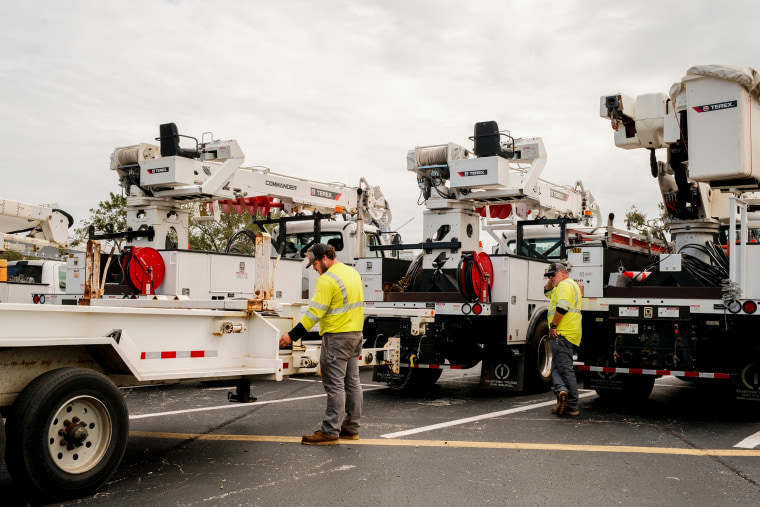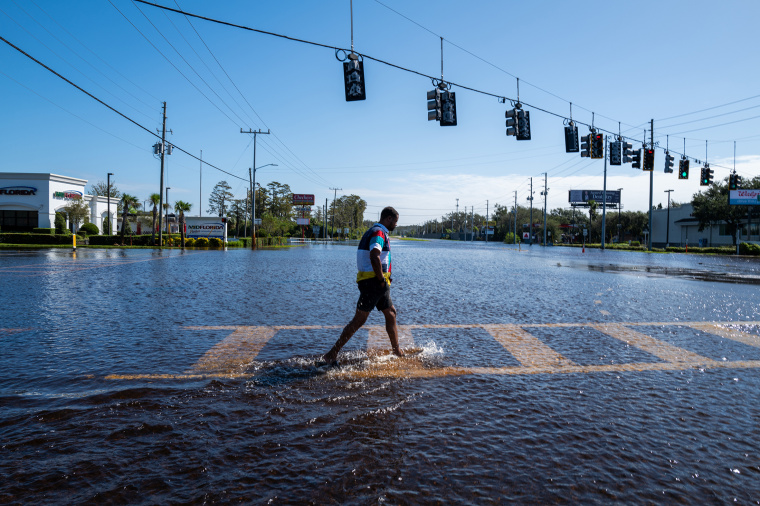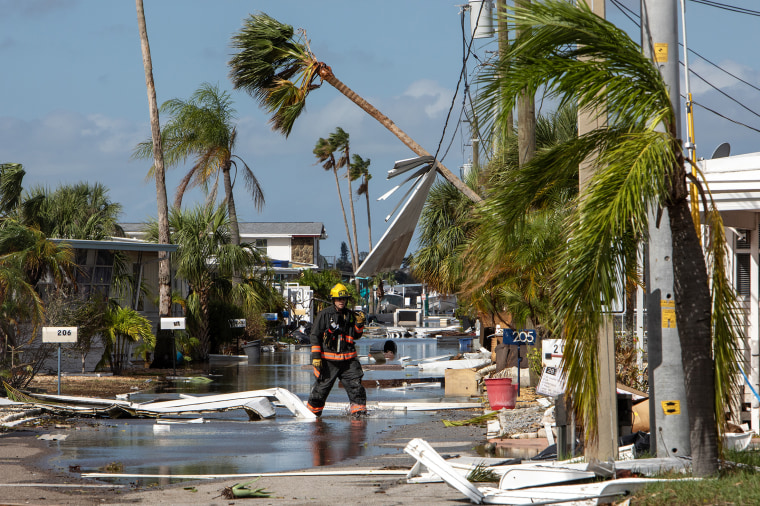As Florida reels, focus turns to restoring power, assisting victims in Hurricane Milton’s wake
Restoring power, clearing debris and distributing fuel are now the top priorities in Florida as the state continues to reel in the wake Hurricane Milton. More than 1.2 million are without power and at least 17 fatalities have been confirmed as recovery efforts continue into the weekend.
Florida Gov. Ron DeSantis said Saturday that efforts are still underway to assist residents and provide resources to hard-hit areas across the state. Parts of western and central Florida continue to face the risk of significant flooding in creeks and rivers continue to rise.
DeSantis said the state is working to address the need for fuel in heavily impacted areas. He said free fuel distribution depots have been opened in Plant City, Bradenton and St. Petersburg, and officials are in the process of opening more in Hillsborough County and Pinellas County.
The Hillsborough County Sheriff’s Office escorted a convoy of fuel trucks on Saturday evening, according to a video posted by the office on X.
Nearly 30% of Florida’s gas stations were without fuel, according to GasBuddy, a web tool that crowdsources fuel pricing and availability. The Tampa and St. Petersburg area is particularly lacking for gasoline, with 78% of stations without fuel.
All major highways and bridges in the Tampa Bay area have reopened. Airports across southwest Florida have also resumed normal operations, except for Sarasota Bradenton International Airport, which DeSantis said is expected to reopen Wednesday.
DeSantis said that while the Tampa Bay area was spared forecasters’ worst-case scenario of storm surge up to 15 feet, strong winds caused considerable damage and heavy rain drove severe urban and inland flooding.
“Tampa Bay did not get the surge that everyone feared, but what you ended up seeing is just massive — on the north side of the storm — huge amounts of water,” he said. “You did have wind, of course, and so that created inland situations where you had a lot of flooding, and water continued to rise even after the storm left.”

President Joe Biden on Friday approved a major disaster declaration for Florida after Hurricane Milton. The approval allows funding to flow for federal assistance programs.
Individuals affected in 34 Florida counties and the Miccosukee Tribe of Indians of Florida are eligible for federal support for temporary housing, low-cost loans and other programs, according to a White House news release. Funding will also flow to local governments and nonprofits for emergency work.
Flooding remains a possibility in parts of the state as river levels are expected to continue rising into next week.
Major hurricanes like Milton can dump enormous amounts of rain over land, causing rivers, lakes and creeks to swell for days — and sometimes weeks — after the storms made landfall.
Milton’s rainfall totals in the Tampa Bay area reached 18.31 inches in St. Petersburg, 14.01 inches in Clearwater Beach, 11.43 inches in Tampa and 10.12 inches in Seminole.
Several waterways in the Tampa area, including the Anclote River, Hillsborough River, Withlacoochee River, Cypress Creek and Alafia River, reached major flood stage on Saturday, according to the National Oceanic and Atmospheric Administration.
NOAA has four categories to communicate risk to the public in any given location from rising streams. In a “major” flood stage, the agency expects “extensive inundation of structures and roads,” with the possible need to evacuate people and transfer property to higher elevations.
The Alafia River crested at 24.34 feet on Friday, and while it has begun slowly receding, NOAA forecasts show it will remain in a major or moderate flood stage through early next week.
The Hillsborough River near Zephyrhills crested at 17.14 feet early Friday, marking its highest flood level on record. Hillsborough County officials on Friday issued several flood warnings, saying rising water levels in several rivers are “creating dangerous conditions for residents.”

Officials in Pasco County said Friday on X that neighborhoods near rivers and lakes were experiencing “historical flooding,” and urged people to immediately leave and seek higher ground.
The Pasco County Sheriff’s Office said in a Facebook post Saturday that it had assisted about 100 residents in a leafy, suburban community off Wesley Chapel Boulevard. The sheriff’s office was asking residents to leave low-lying areas.
Pasco County Fire Rescue on Saturday conducted a swift-water boat patrol, checking water depth and searching for anyone potentially stuck in their houses.

A heavy current surged down neighborhood streets with water rising as high as four feet, submerging many mailboxes to the top.
Street signs poked up from murky depths as the rescuers patrolled floodwaters in a candy-apple red inflatable boat.
Keith March, a captain with Pasco County Fire Rescue, said the current was deceptively strong, and had plenty of power to carry people away.
“When the river is moving, it can move up to 4,000 pounds per square inch and you can’t fight that as a human,” March said.
The rescues were starting to blur together for the crew with memories of Hurricane Helene mixing with operations for Milton.
“We’ve gotten lucky. We haven’t had to deal with any gators or anything so far,” March said.
Water levels are expected to continue rising in the coming days, posing a major flood risk in low-lying parts of the county, officials said.
Parts of central Florida are also facing elevated risks of flooding due to high water levels in the St. Johns River and Ocklawaha River.

